Question groups - introduction/sl: Difference between revisions
From LimeSurvey Manual
(Created page with "Preden lahko dodate vprašanje v vašo anketo morate ustvariti skupino. Novo skupino ustvarite s klikom na gumb "Dodaj novo skupino vprašanj anketi" ...") |
(Updating to match new version of source page) |
||
| (23 intermediate revisions by 3 users not shown) | |||
| Line 1: | Line 1: | ||
<languages /> __TOC__ | <languages /> __TOC__ | ||
<div class="simplebox">[[File:help.png]] Please note that the below explanations and screenshots are based on LimeSurvey 3.</div> | |||
= | =Create question group= | ||
To start adding question groups to your survey, access the [[Survey structure|survey structure]] page and locate in the left menu the '''add question group''' button. | |||
<center>[[File:Option 2 - create a question group.png]]</center> | |||
After you click on it, the add question group panel will be showed up: | |||
<center>[[File:Add question group panel.png]]</center> | |||
<div class="mw-translate-fuzzy"> | |||
Ustvarite lahko toliko skupin kot želite. | |||
</div> | |||
The following fields will be displayed: | |||
*'''Title:''' Type in this box the name you wish to give to the question group; | |||
<div class="mw-translate-fuzzy"> | |||
Skupina lahko vsebuje tudi "opis". To polje vam omogoča, da objavite pojasnilo za vsak sklop vprašanj. Če dodate opis, bo predstavljen v anketi pred začetkom posameznega vprašanja v tej skupini. Če ne vključite nobenega besedila, bodo anketiranci enostavno pričeli z reševanjem prvega vprašanja v skupini. S HTML urejevalnikom lahko vključite slike, oblikovano besedilo, itd. | |||
</div> | |||
<div class="mw-translate-fuzzy"> | |||
Z verzijo 2.0 in višje lahko nastavite naključni vrstni red skupin vprašanj. Da to storite, vnesite niz v polje 'Naključna postavitev skupin vprašanj'. Isti niz boste morali vnesti v vseh drugih skupinah, ki jih želite naključno razvrščati in ki se bodo nato v anketi prikazovale v naključnem vrstnem redu. | |||
</div> | |||
<div class="mw-translate-fuzzy"> | |||
Od verzije 1.92 dalje lahko nastavite enačbo relevantnosti za posamezno skupino z [[Expression Manager/sl|Urejevalnikom izrazov]]. To vam bo v pomoč pri "zankanju" ali v drugih primerih, ko se podobna vsebina večkrat ponovi. Na primer: recimo, da želite postaviti podoben niz vprašanj za vsake posameznega otroka v gospodinjstvu. Pri tem vprašate koliko otrok je v gospodinjstvu preko vprašanja poimenovanega "numKids". ?????????? | |||
***************************** Primer mi ni jasen kaj želi povedati. | |||
</div> | |||
<div class="mw-translate-fuzzy"> | |||
Pojasnilo in primer za skrivanje skupine vprašanj je dosegljiv na [[Expression Manager Examples#Hide_question_group_if_answer_from_previous_question_is_Yes_or_No/sl|Stran s primeri urejevalnika izrazov]]. | |||
</div> | |||
<div class="mw-translate-fuzzy"> | |||
Skupine se uporabljajo za razporejanje vprašanj v anketi. Če boste imeli več skupin, morate upoštevati, da boste vprašanja razporejali v ustrezne skupine (le to lahko spreminjate v nastavitvah ankete). Za prikaz skupine v določenem vrstnem redu uporabite funkcijo reorganizacija. Če pa imate le eno skupino v anketi, je njeno ime nepomembno (razen seveda za prikaz). | |||
</div> | |||
==Add question group toolbar== | |||
You may find on the top toolbar the following options: | |||
<center>[[File:Add question group - toolbar.png]]</center> | |||
* '''Display/Export''': This function is used to export your whole survey in different formats; | |||
* '''Survey participants:''' Clicking on this button will redirect the survey administrator to his/her [[Survey participants|survey participants table]]; | |||
* '''Responses:''' If the survey is active, the button becomes visible. It offers you access to the responses table; | |||
* '''Import a group:''' Besides the two ways [[Question groups - introduction#Create question group|mentioned above]], new question groups can also be added via the [[Question groups - introduction#Import a question group|import group function]]. | |||
==Import a question group== | |||
You can also import a question group (.lsg file format) that was previously exported from a LimeSurvey survey. First, access the '''add question group''' option and then locate on the top toolbar the import question group function: | |||
<center>[[File:Import question group 1.png]]</center> | |||
Browse your computer/server and upload the .lsg file that contains the question group you wish to import. | |||
=Question group actions= | |||
After the creation of a survey, you can access the newly created group from the [[Survey structure|survey structure]] menu. The following page will be displayed: | |||
<center>[[File:Question group - after its creation.png]]</center> | |||
The page is divided into three sections: | |||
*'''Question group toolbar:''' You may find on the toolbar the following options: | |||
**''Preview survey/question group:'' Click on one of the two buttons to either preview your whole survey or only the current question group. If additional languages were added to your survey, the survey/question group can be previewed in each language of the survey. Just simply click on one of the two ''preview'' buttons and select the desired language; | |||
**''Edit current question group:'' Click on this button if you wish to edit the title, description, relevance equation, or randomization group of the current question group; | |||
**''Check survey logic for current question group:'' It helps you see the possible errors that might exist within a question group - it is especially useful when the [[ExpressionScript - Presentation|ExpressionScript]] is used. | |||
**''Delete current question group:'' If you wish to delete the current question group, click on this button. | |||
**''Export this question group:'' If you wish to export this question group to later import it into another LimeSurvey survey, click on this button. The file will be exported in the .lsg format. | |||
*'''Group summary:''' The main [[Question groups - introduction#Create question group|question group details are displayed]]; | |||
*'''Group quick actions:''' It allows you to quickly perform question-groups-related actions - in our case, the add new question to group option is displayed. To find out more about questions, read our [[Questions - introduction|introductory wiki section on question]]. | |||
=Preview question group= | |||
Once you have started to add questions into your group, you may want from time to time to preview how the respective question group looks like. To do that, look for the '''question group''' button that can be accessed from the: | |||
*[[Question groups - introduction#Preview question group - survey structure|survey structure menu]] | |||
*[[Question groups - introduction#Preview question group - question group panel|question group panel]] | |||
*[[Question groups - introduction#Preview question group - question panel|question panel]] | |||
{{Note|When preview a group, the relevance of this group is forced to be true.}} | |||
{{Hint|Text=You can add [[URL_fields#Prefilling_a_survey_using_GET_parameters|GET params in URL]] to prefill questions.}} | |||
==Preview question group - survey structure== | |||
Click on the survey structure, select the desired question group, and click on the '''preview question group''' button: | |||
<center>[[File:Preview q group - survey structure.png]]</center> | |||
==Preview question group - question group panel== | |||
You can preview the question group once you have finished editing it: | |||
<center>[[File:Question group panel - preview.png]]</center> | |||
==Preview question group - question panel== | |||
The question group to which question belongs to can be previewed from the question panel - see the top bar: | |||
<center>[[File:Preview question group - question panel.png]]</center> | |||
=Reordering question groups= | |||
The question groups and questions can be reordered as many times as you like. For further details, check the following [[Survey structure#Reordering questions and question groups|survey structure wiki subsection]]. | |||
=Example= | |||
The relevance equation offers us many possibilities to further customize our survey. A simple example is presented below to show how some question groups can be hidden according to the answer provided by the respondent to a prior question (part of another question group). For example, if you want to find out more information about parents that have one child in comparison to those with two or more, using the relevance equation to hide certain questions/question groups could be recommended. | |||
Link .lss file: [[Media:Question_groups_simple_example.zip|Question_groups_simple_example.zip]] -> to import it, read the following [[Surveys_-_introduction#Import_a_survey|wiki section]]. | |||
<center>[[File:Logic file question groups example.png]]</center> | |||
The above file contains three question groups, each containing one question. Question group "1kid" is displayed only if the value introduced by the respondent to the question "numkids" is 1. Question group "2ormorekids" is displayed only if the answer to the question "numkids" is >1. | |||
This is just a simple example to show you how expressions can be used to further customize your survey. For further details, please start reading further about the [[ExpressionScript - Presentation|ExpressionScript]]. | |||
<div class='simplebox'>[[File:help.png]] '''Notes:''' | |||
*There are many ways through which you can hide questions. One way is to use [[Setting conditions|conditions]]. However, for more complex surveys, the [[ExpressionScript - Presentation|ExpressionScript]] has to be used. | |||
*If you use expressions, don't forget to look for syntax errors with the help of the logic file.</div> | |||
Revision as of 16:40, 19 May 2020
Create question group
To start adding question groups to your survey, access the survey structure page and locate in the left menu the add question group button.
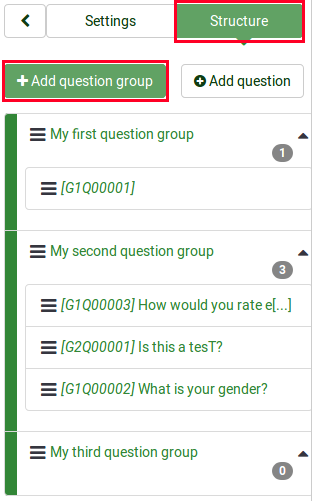
After you click on it, the add question group panel will be showed up:
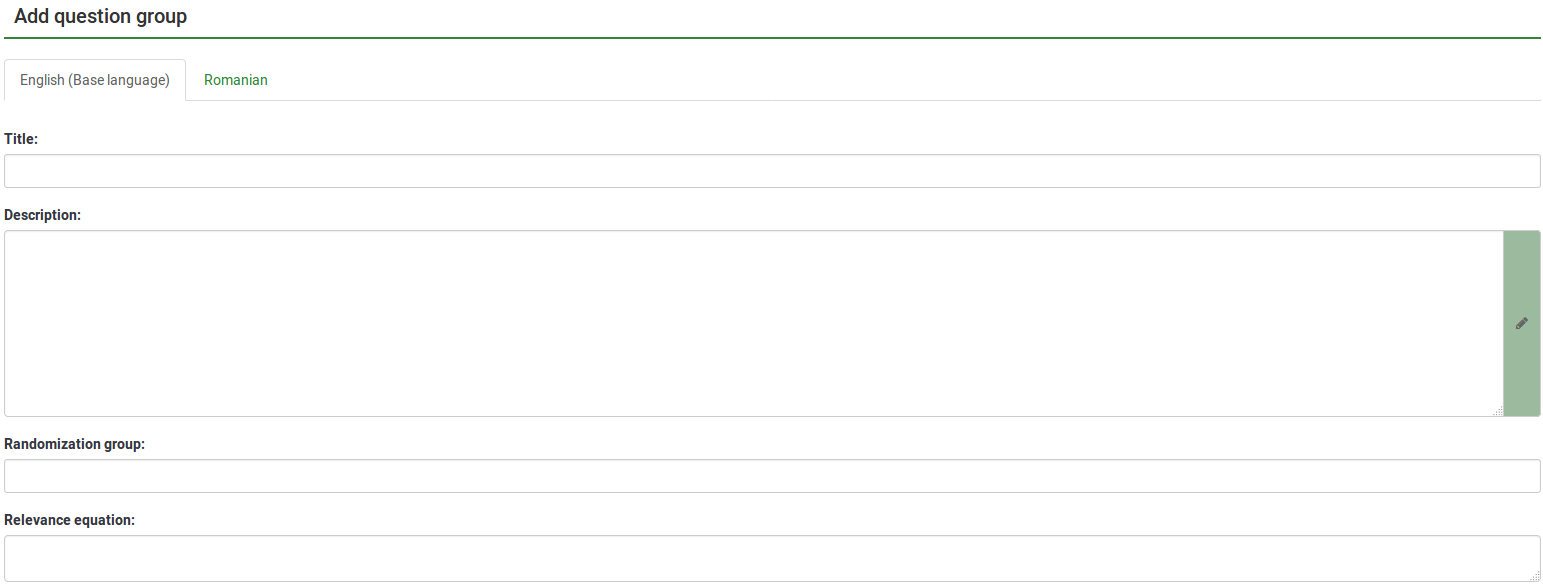
Ustvarite lahko toliko skupin kot želite.
The following fields will be displayed:
- Title: Type in this box the name you wish to give to the question group;
Skupina lahko vsebuje tudi "opis". To polje vam omogoča, da objavite pojasnilo za vsak sklop vprašanj. Če dodate opis, bo predstavljen v anketi pred začetkom posameznega vprašanja v tej skupini. Če ne vključite nobenega besedila, bodo anketiranci enostavno pričeli z reševanjem prvega vprašanja v skupini. S HTML urejevalnikom lahko vključite slike, oblikovano besedilo, itd.
Z verzijo 2.0 in višje lahko nastavite naključni vrstni red skupin vprašanj. Da to storite, vnesite niz v polje 'Naključna postavitev skupin vprašanj'. Isti niz boste morali vnesti v vseh drugih skupinah, ki jih želite naključno razvrščati in ki se bodo nato v anketi prikazovale v naključnem vrstnem redu.
Od verzije 1.92 dalje lahko nastavite enačbo relevantnosti za posamezno skupino z Urejevalnikom izrazov. To vam bo v pomoč pri "zankanju" ali v drugih primerih, ko se podobna vsebina večkrat ponovi. Na primer: recimo, da želite postaviti podoben niz vprašanj za vsake posameznega otroka v gospodinjstvu. Pri tem vprašate koliko otrok je v gospodinjstvu preko vprašanja poimenovanega "numKids". ??????????
- Primer mi ni jasen kaj želi povedati.
Pojasnilo in primer za skrivanje skupine vprašanj je dosegljiv na Stran s primeri urejevalnika izrazov.
Skupine se uporabljajo za razporejanje vprašanj v anketi. Če boste imeli več skupin, morate upoštevati, da boste vprašanja razporejali v ustrezne skupine (le to lahko spreminjate v nastavitvah ankete). Za prikaz skupine v določenem vrstnem redu uporabite funkcijo reorganizacija. Če pa imate le eno skupino v anketi, je njeno ime nepomembno (razen seveda za prikaz).
Add question group toolbar
You may find on the top toolbar the following options:
- Display/Export: This function is used to export your whole survey in different formats;
- Survey participants: Clicking on this button will redirect the survey administrator to his/her survey participants table;
- Responses: If the survey is active, the button becomes visible. It offers you access to the responses table;
- Import a group: Besides the two ways mentioned above, new question groups can also be added via the import group function.
Import a question group
You can also import a question group (.lsg file format) that was previously exported from a LimeSurvey survey. First, access the add question group option and then locate on the top toolbar the import question group function:
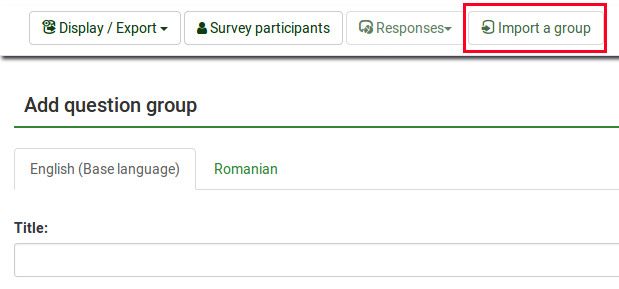
Browse your computer/server and upload the .lsg file that contains the question group you wish to import.
Question group actions
After the creation of a survey, you can access the newly created group from the survey structure menu. The following page will be displayed:

The page is divided into three sections:
- Question group toolbar: You may find on the toolbar the following options:
- Preview survey/question group: Click on one of the two buttons to either preview your whole survey or only the current question group. If additional languages were added to your survey, the survey/question group can be previewed in each language of the survey. Just simply click on one of the two preview buttons and select the desired language;
- Edit current question group: Click on this button if you wish to edit the title, description, relevance equation, or randomization group of the current question group;
- Check survey logic for current question group: It helps you see the possible errors that might exist within a question group - it is especially useful when the ExpressionScript is used.
- Delete current question group: If you wish to delete the current question group, click on this button.
- Export this question group: If you wish to export this question group to later import it into another LimeSurvey survey, click on this button. The file will be exported in the .lsg format.
- Group summary: The main question group details are displayed;
- Group quick actions: It allows you to quickly perform question-groups-related actions - in our case, the add new question to group option is displayed. To find out more about questions, read our introductory wiki section on question.
Preview question group
Once you have started to add questions into your group, you may want from time to time to preview how the respective question group looks like. To do that, look for the question group button that can be accessed from the:

Preview question group - survey structure
Click on the survey structure, select the desired question group, and click on the preview question group button:

Preview question group - question group panel
You can preview the question group once you have finished editing it:
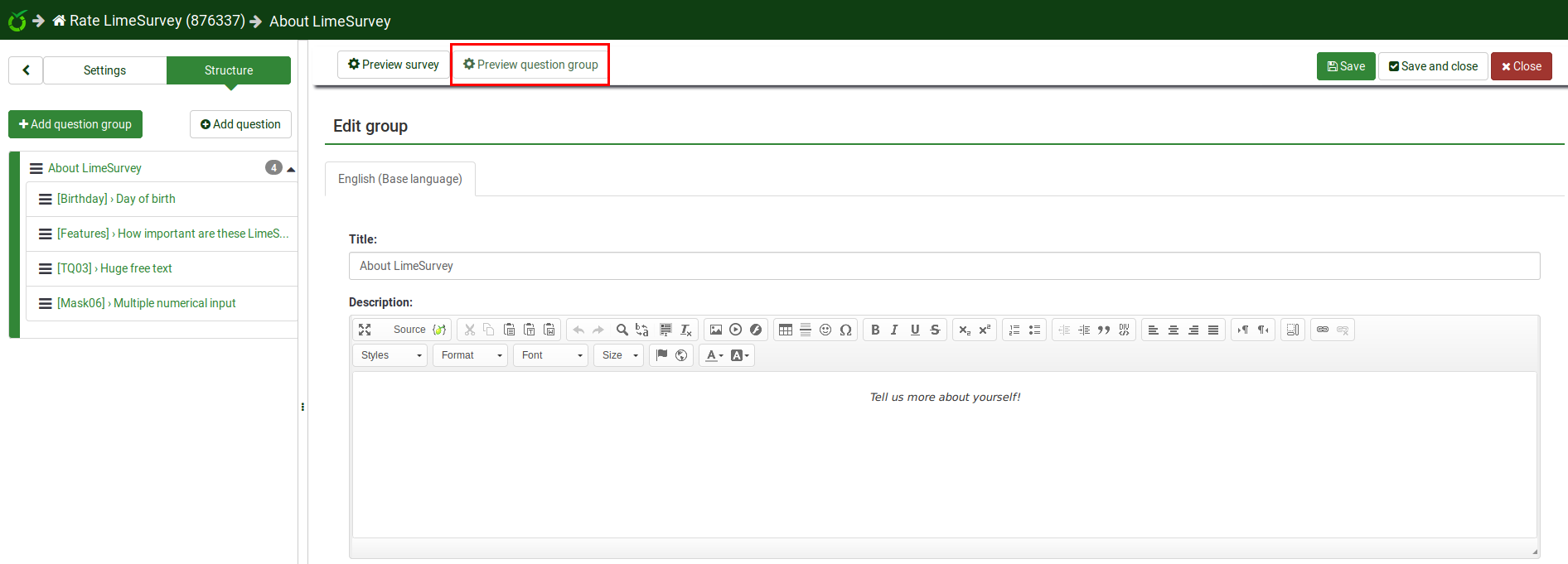
Preview question group - question panel
The question group to which question belongs to can be previewed from the question panel - see the top bar:
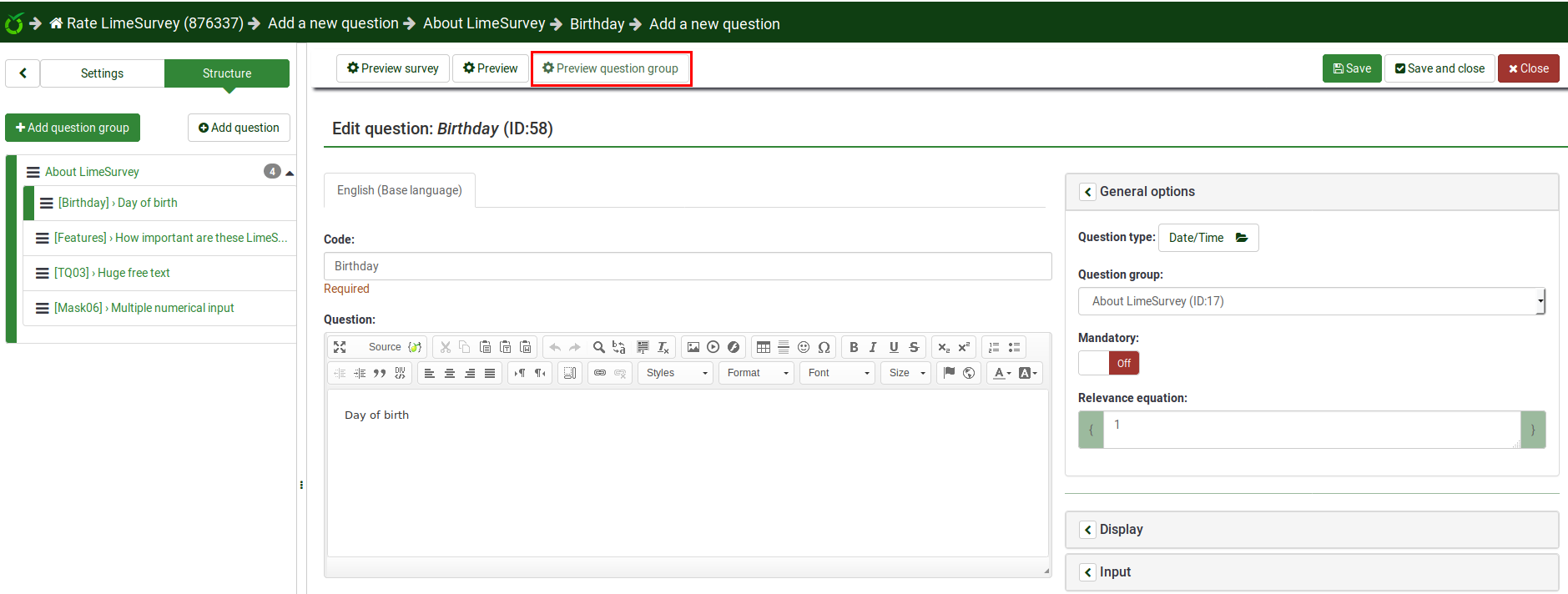
Reordering question groups
The question groups and questions can be reordered as many times as you like. For further details, check the following survey structure wiki subsection.
Example
The relevance equation offers us many possibilities to further customize our survey. A simple example is presented below to show how some question groups can be hidden according to the answer provided by the respondent to a prior question (part of another question group). For example, if you want to find out more information about parents that have one child in comparison to those with two or more, using the relevance equation to hide certain questions/question groups could be recommended.
Link .lss file: Question_groups_simple_example.zip -> to import it, read the following wiki section.
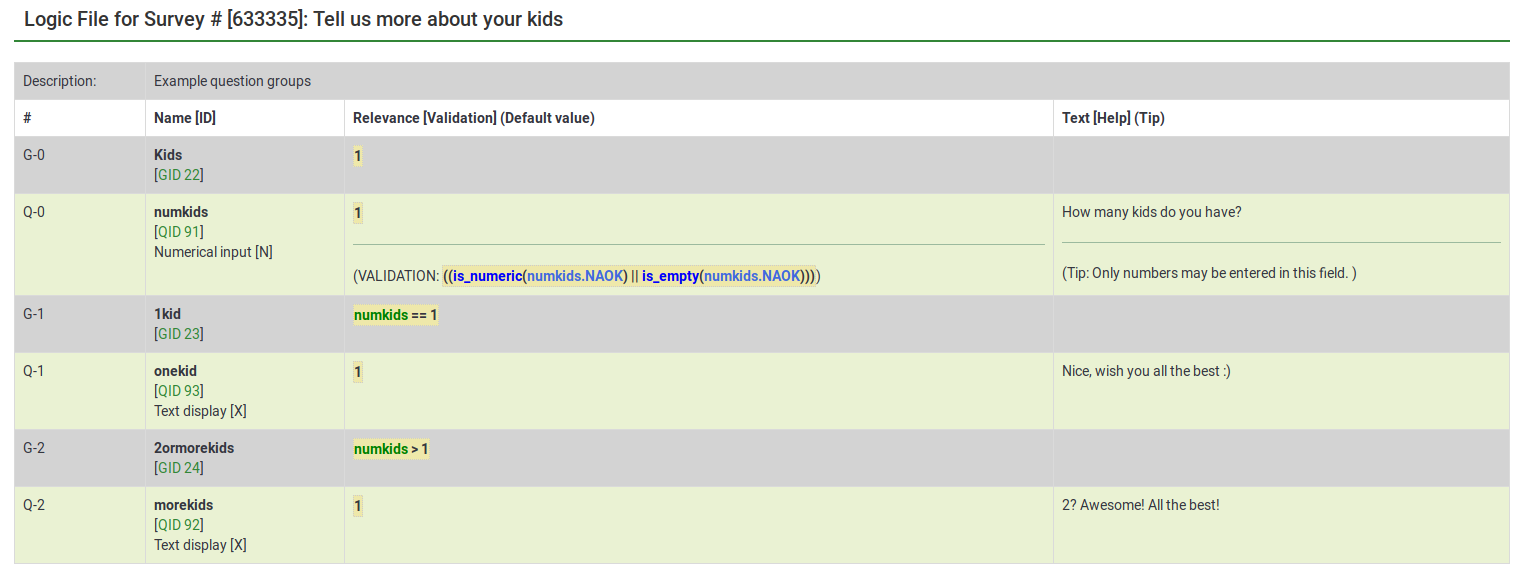
The above file contains three question groups, each containing one question. Question group "1kid" is displayed only if the value introduced by the respondent to the question "numkids" is 1. Question group "2ormorekids" is displayed only if the answer to the question "numkids" is >1.
This is just a simple example to show you how expressions can be used to further customize your survey. For further details, please start reading further about the ExpressionScript.
- There are many ways through which you can hide questions. One way is to use conditions. However, for more complex surveys, the ExpressionScript has to be used.
- If you use expressions, don't forget to look for syntax errors with the help of the logic file.